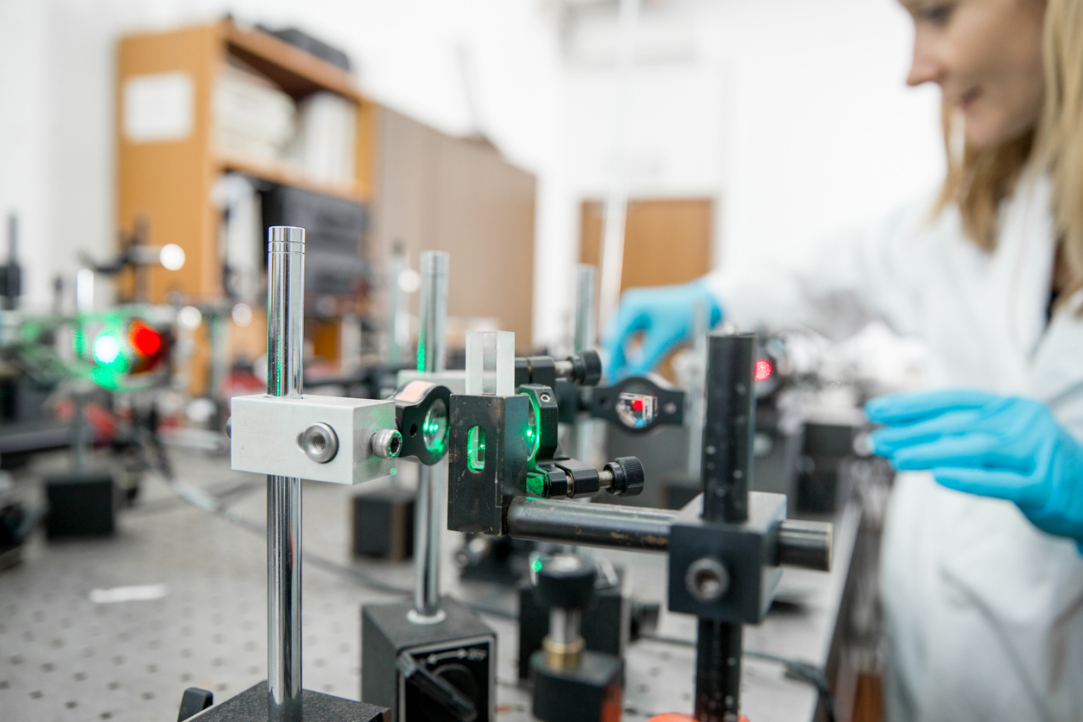Russian Scientists Integrate Microdisk Laser and Waveguide on a Single Substrate

A group of Russian scientists led by Professor Natalia Kryzhanovskaya at HSE Campus in St Petersburg has been researching microdisk lasers with an active region based on arsenide quantum dots. For the first time, researchers have successfully developed a microdisk laser coupled with an optical waveguide and a photodetector on a single substrate. This design enables the implementation of a basic photonic circuit on the same substrate as the radiation source (microlaser). In the future, this will help speed up data transfer and reduce equipment weight without compromising quality. The study results have been published in Semiconductors.
The growing demands for higher speed and larger volumes of transmitted information necessitate improvements to current communication methods. Photonic integrated circuits (PICs), which use light to transmit information, operate faster, generate less heat, are more resistant to interference, and consume less energy compared to their electronic counterparts.
However, their effective use requires efficient, compact light sources, such as gallium arsenide (GaAs) microdisk lasers. The length of a conventional Fabry–Perot laser is around 1 mm, while a microdisk laser can be up to 1,000 times smaller. In this study, the laser size was reduced to a diameter of 30 to 40 microns.
Effective directional radiation output is essential for the successful implementation of optical communication in photonic integrated circuits (PICs). Directional radiation can be achieved by optically coupling microlasers with a nearby waveguide. The authors of the paper designed and fabricated both a microlaser and a waveguide from a single epitaxial structure, resulting in reduced size and increased stability.
'Creating microdisk lasers coupled to a waveguide is a challenging task. This process involves developing a thin-film epitaxial structure with a specific composition. In our case, we employed gas-phase epitaxy of metal-organic compounds, a method for layered formation of crystals of different substances on top of one another. Lasers and waveguides were created from the resulting structure. This was made possible thanks to the innovations developed by the Mokerov Institute of Ultra High Frequency Semiconductor Electronics of the Russian Academy of Sciences. All these processes required the use of advanced technology and the efforts of a team of experienced, talented, and qualified specialists,' according to Nikita Fominykh, Junior Research Fellow of the International Laboratory of Quantum Optoelectronics at HSE Campus in St Petersburg.
In addition to radiation sources, radiation receivers are also essential for the operation of PICs. In this work, waveguide photodetectors fulfil this role. Thus, it becomes possible to create an optocoupler that combines a microlaser and a waveguide photodetector with a matching operating wavelength on a single substrate. The photodetector used in the optocoupler measured no more than 90 microns, enabling the creation of a highly compact and energy-efficient optocoupler.
'Microdisk lasers are unique optoelectronic devices. With a size comparable to the diameter of a spider silk thread, they can generate a significant amount of optical power. We have experimentally demonstrated that all optoelectronic components necessary for a photonic integrated circuit—a microdisk laser, a waveguide, and a photodetector—can be fabricated from a single epitaxial heterostructure on the same substrate,' says co-author of the paper Natalia Kryzhanovskaya, Head of the International Laboratory of Quantum Optoelectronics at HSE Campus in St Petersburg.
See also:
When a Virus Steps on a Mine: Ancient Mechanism of Infected Cell Self-Destruction Discovered
When a virus enters a cell, it disrupts the cell’s normal functions. It was previously believed that the cell's protective response to the virus triggered cellular self-destruction. However, a study involving bioinformatics researchers at HSE University has revealed a different mechanism: the cell does not react to the virus itself but to its own transcripts, which become abnormally long. The study has been published in Nature.
Researchers Identify Link between Bilingualism and Cognitive Efficiency
An international team of researchers, including scholars from HSE University, has discovered that knowledge of a foreign language can improve memory performance and increase automaticity when solving complex tasks. The higher a person’s language proficiency, the stronger the effect. The results have been published in the journal Brain and Cognition.
Artificial Intelligence Transforms Employment in Russian Companies
Russian enterprises rank among the world’s top ten leaders in AI adoption. In 2023, nearly one-third of domestic companies reported using artificial intelligence. According to a new study by Larisa Smirnykh, Professor at the HSE Faculty of Economic Sciences, the impact of digitalisation on employment is uneven: while the introduction of AI in small and large enterprises led to a reduction in the number of employees, in medium-sized companies, on the contrary, it contributed to job growth. The article has been published in Voprosy Ekonomiki.
Lost Signal: How Solar Activity Silenced Earth's Radiation
Researchers from HSE University and the Space Research Institute of the Russian Academy of Sciences analysed seven years of data from the ERG (Arase) satellite and, for the first time, provided a detailed description of a new type of radio emission from near-Earth space—the hectometric continuum, first discovered in 2017. The researchers found that this radiation appears a few hours after sunset and disappears one to three hours after sunrise. It was most frequently observed during the summer months and less often in spring and autumn. However, by mid-2022, when the Sun entered a phase of increased activity, the radiation had completely vanished—though the scientists believe the signal may reappear in the future. The study has been published in the Journal of Geophysical Research: Space Physics.
Banking Crises Drive Biodiversity Loss
Economists from HSE University, MGIMO University, and Bocconi University have found that financial crises have a significant negative impact on biodiversity and the environment. This relationship appears to be bi-directional: as global biodiversity declines, the likelihood of new crises increases. The study examines the status of populations encompassing thousands of species worldwide over the past 50 years. The article has been published in Economics Letters, an international journal.
Scientists Discover That the Brain Responds to Others’ Actions as if They Were Its Own
When we watch someone move their finger, our brain doesn’t remain passive. Research conducted by scientists from HSE University and Lausanne University Hospital shows that observing movement activates the motor cortex as if we were performing the action ourselves—while simultaneously ‘silencing’ unnecessary muscles. The findings were published in Scientific Reports.
Russian Scientists Investigate Age-Related Differences in Brain Damage Volume Following Childhood Stroke
A team of Russian scientists and clinicians, including Sofya Kulikova from HSE University in Perm, compared the extent and characteristics of brain damage in children who experienced a stroke either within the first four weeks of life or before the age of two. The researchers found that the younger the child, the more extensive the brain damage—particularly in the frontal and parietal lobes, which are responsible for movement, language, and thinking. The study, published in Neuroscience and Behavioral Physiology, provides insights into how age can influence the nature and extent of brain lesions and lays the groundwork for developing personalised rehabilitation programmes for children who experience a stroke early in life.
Scientists Test Asymmetry Between Matter and Antimatter
An international team, including scientists from HSE University, has collected and analysed data from dozens of experiments on charm mixing—the process in which an unstable charm meson oscillates between its particle and antiparticle states. These oscillations were observed only four times per thousand decays, fully consistent with the predictions of the Standard Model. This indicates that no signs of new physics have yet been detected in these processes, and if unknown particles do exist, they are likely too heavy to be observed with current equipment. The paper has been published in Physical Review D.
HSE Scientists Reveal What Drives Public Trust in Science
Researchers at HSE ISSEK have analysed the level of trust in scientific knowledge in Russian society and the factors shaping attitudes and perceptions. It was found that trust in science depends more on everyday experience, social expectations, and the perceived promises of science than on objective knowledge. The article has been published in Universe of Russia.
Scientists Uncover Why Consumers Are Reluctant to Pay for Sugar-Free Products
Researchers at the HSE Institute for Cognitive Neuroscience have investigated how 'sugar-free' labelling affects consumers’ willingness to pay for such products. It was found that the label has little impact on the products’ appeal due to a trade-off between sweetness and healthiness: on the one hand, the label can deter consumers by implying an inferior taste, while on the other, it signals potential health benefits. The study findings have been published in Frontiers in Nutrition.




